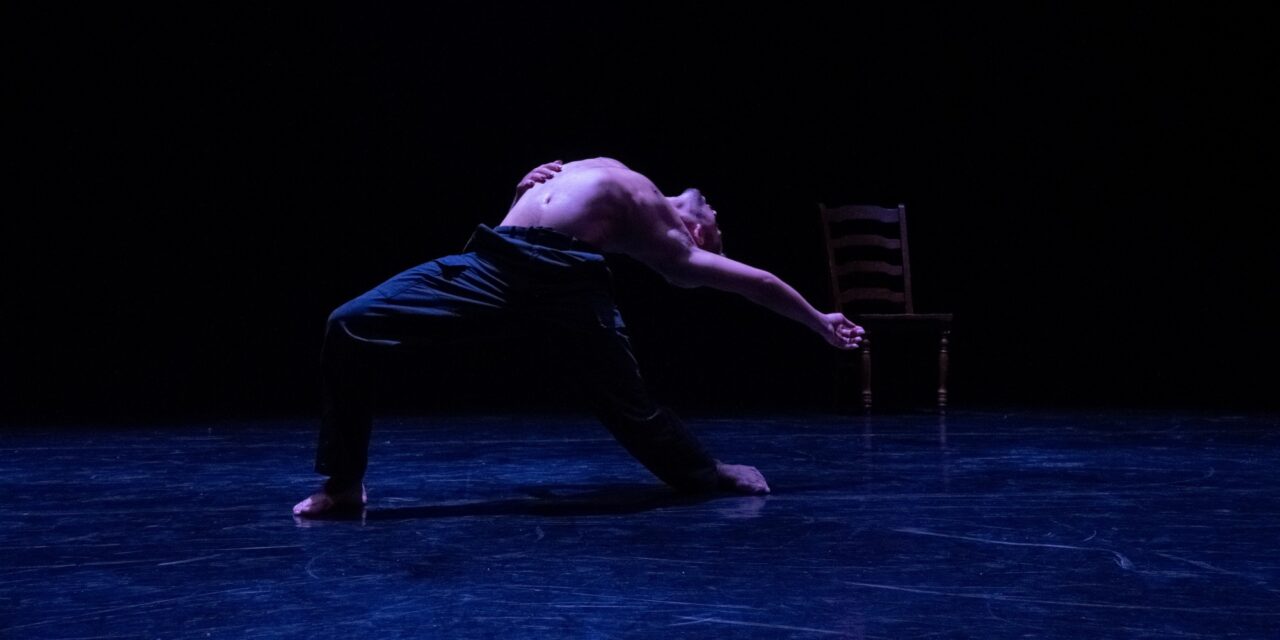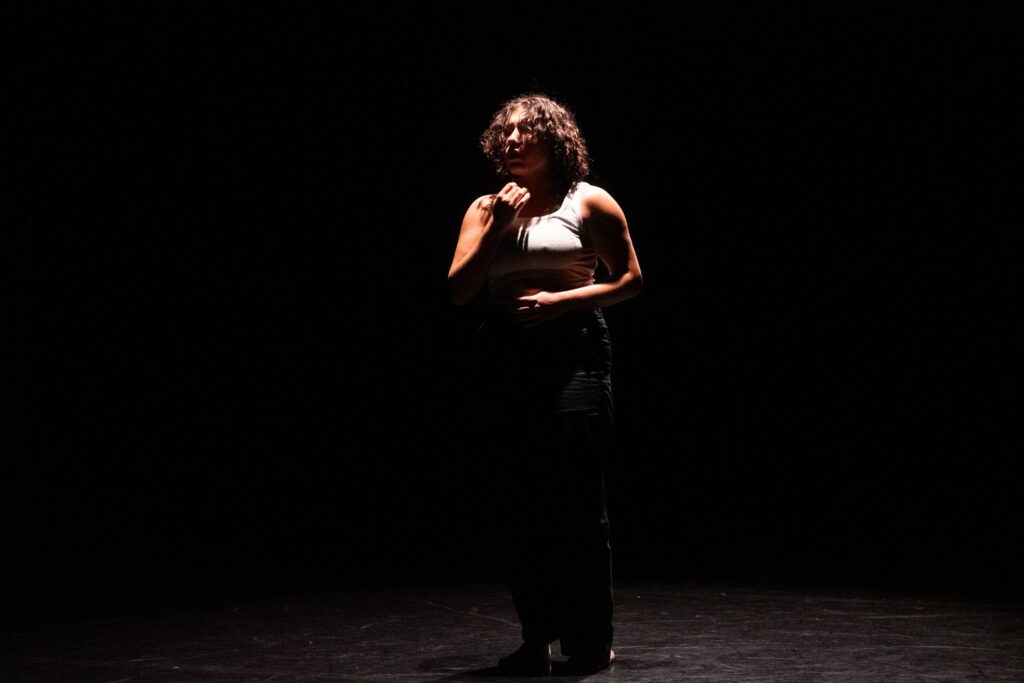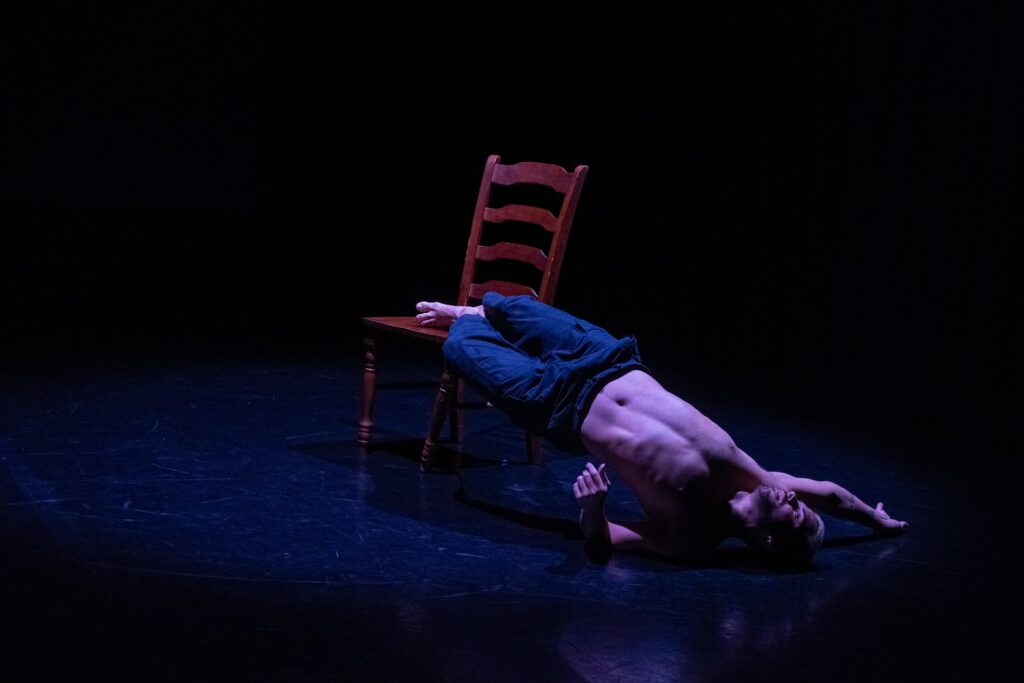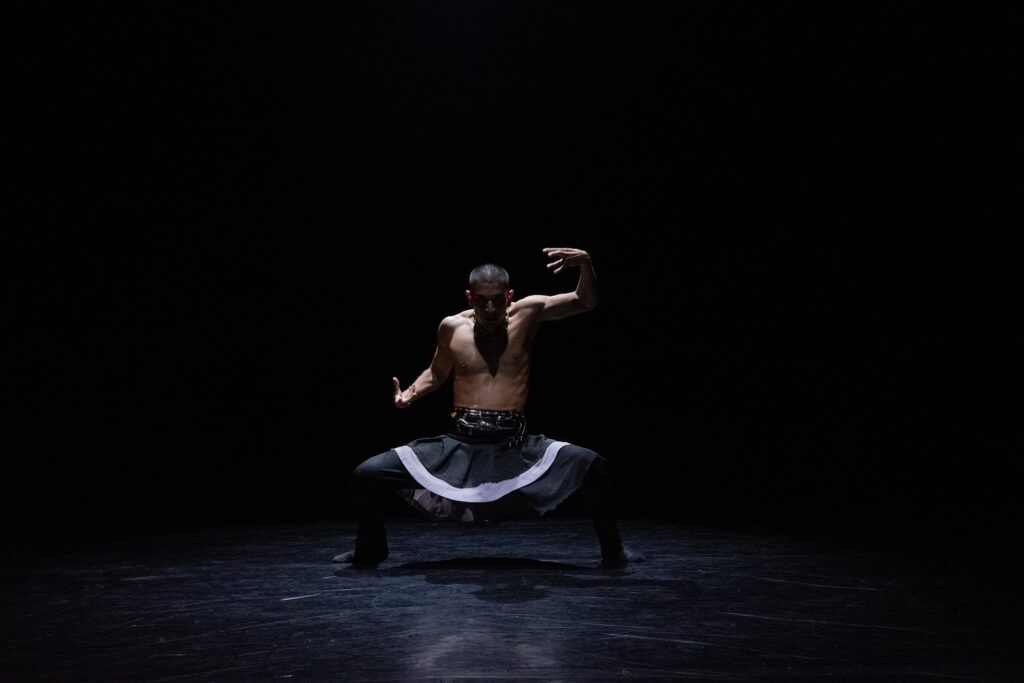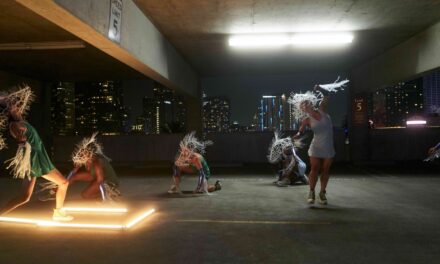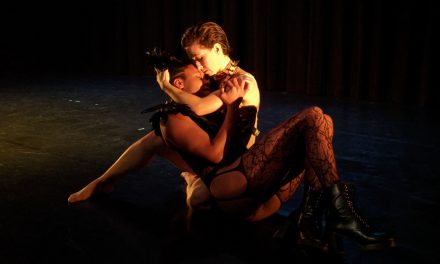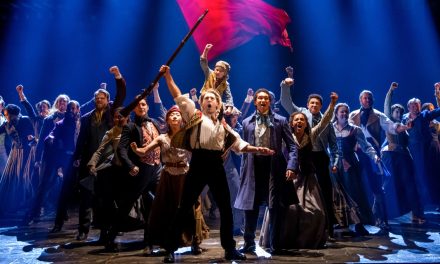Derrick Paris is a dancer, a fine choreographer and the founder and director of VOICES that just had its seventh showcase at Stomping Ground L.A. featuring ten Latine or indigenous dance artists. The venue was overflowing with friends, family and colleagues who welcomed each artist with shouts of encouragement. The choreography was wide ranged with a few outstanding works and several that appeared to be promising works-in-progress. Paris has created an avenue for underrepresented dance artists to be seen and their voices heard.
Cuerdas de ti was a stunning and provocative work choreographed and performed by Isabella Mendoza (She/Her) to live guitar performed by Mariano Camacho. Dressed in a plain white dress, Mendoza is first seen kneeling in front of Camacho as he plays the opening of his piece. In a surprise move, Camacho hits a loud chord and Mendoza throws herself into a lying position as if knocked down by an invisible force.
Mendoza understands the power of subtlety and stillness to enhance the more angry and tensely enacted movements. A particularly beautiful and powerful moment was when she very slowly descends to the floor without any accents or facial angst. It rang out as acknowledgement of defeat, but she did not give in to her tormentors. Cuerdas de ti was an extraordinary work and I look forward to seeing more of Mendoza’s choreography.
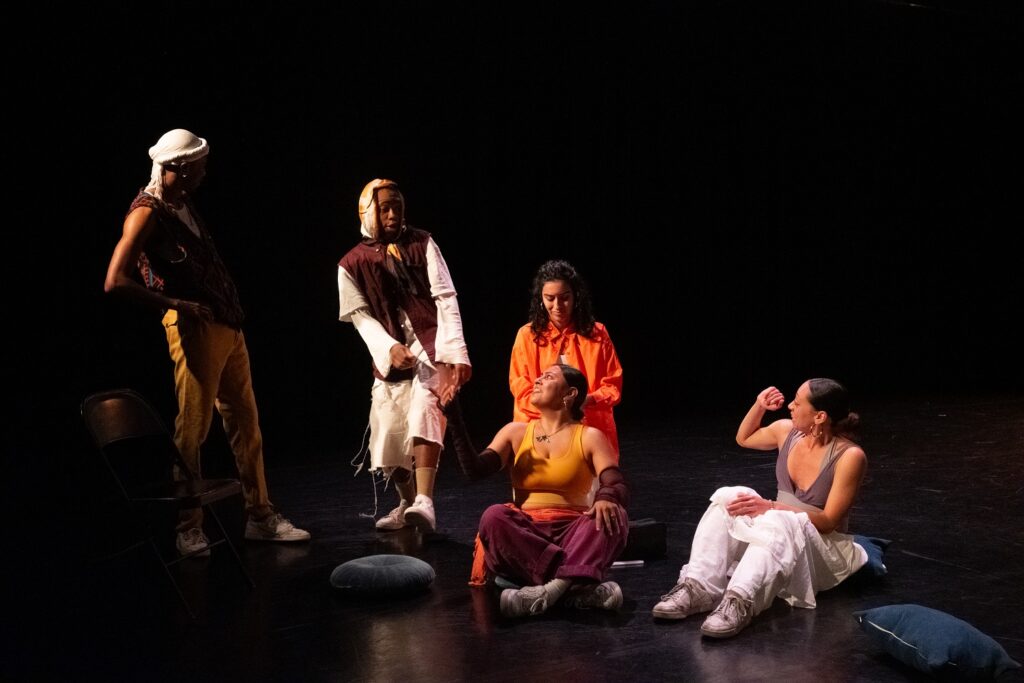
VOICES – L-R G’bari Gilliam, Elizabeth EasLos Rodriguez, Allen El Gato, Jovahna Solalindez Rivas, Monique Berber, Shantel Ureña in “Journey”, choreography by Shantel Ureña – Photo by Victoria Roman.
Journey was an interesting piece choreographed by Shantel Ureña (She/Her) created to music by DJ Jose Marquez and Celia Cruz with poetry by Sandy Vazquez and Shantel Ureña performed by Sandy Vazquez. The movement was a fusion of street, club dance, hip hop and contemporary dance styles. It was almost a dance theater piece about friends and friendships. Built in two sections, the fiends were first seen outside picking fruit and we got a chance to see their personalities and movement preferences. Section two took them inside one person’s apartment where the women are styling one woman’s hair as the guys enter and a party evolves. As seen on this night, Journey was a beautiful glimpse into the lives of a rich culture. The work has promise and Ureña should continue to develop it.
The full cast of Journey included: G’bari Gilliam, Elizabeth “EasLos” Rodriguez, Allen El Gato, Jovahna Solalindez Rivas, Monique Berber, and Shantel Ureña.
The next piece, MI CORAZÓN was choreographed by Krystal Castillo (They/she) to music by Fernando Villalona, Vicente Garcia, and others. Although very short and definitely a work in progress, I found the work endearing. What was not yet developed were the five women’s relationship to each other and why they were there. MI CORAZÓN (My Heart) appears to be more than just a movement work, but the story has not been clearly told.
The very strong dancers in MI CORAZÓN were Krystal Castillo, Jess Alba , Celine Rogers, Leslie Romero, and Erika Soto.
Another highlight of the evening was What Goes Around choreographed by JM Rodriguez (He/Him) and performed to near perfection by Ryan Roozie, Sandy Strangis, and Joseph Stevens. Created to music by Ori Lichtik who is considered one of the founding fathers of the techno scene in Israel. His music was as driving as Rodriguez’s choreography and the dancers kept up with both throughout the work that was filled with complex weaving of partnering and supportive lifts. One outstanding section was when the three dancers formed a diagonal from up left to down right, each in their own light pool, performing different but relatable solos suddenly meshed into a unison phrase that then brought them together again.
Rodriguez has been seen working with several groups in Los Angeles, most prominently L.A. Contemporary Dance Company where his dancing is one of the strongest. Let’s hope that he continues to create more dance works.
Santiago Villarreal (He/Him) is a very strong and charismatic performer, but what distracts from his piece titled Aquí is that he tends to throw in complex and technically difficult dance “tricks” that distracts from what he is trying to say. First seen performing with a single wooden chair, Aquí had the potential of becoming a searingly emotional work, but once Villarreal left the chair he left the meat of his story behind.
His dancing definitely had a wow factor and the audience ate it up. When one looked deeper, however, those double turns caused Villarreal to lose character. Villarreal is very gifted and needs coaching on his acting to help him stay in character. Aquí was created to music by Ed Maverick.
lluvia eterna, choreographed by Orlando Paz (He/Him) began with a film of dancer, Michaela Ramierz, wearing a fire engine red dress and performing intense filled movements on a landscape of sand. It was not clear if this was coastal or somewhere in the desert, but Ramierz is a beautiful mover and her character struggle came through loud and clear. When Ramierz appears live wearing a long white dress, the message of Paz’s work was moving forward no matter what and it was greatly enhanced by the performance by Ramirez.
The music for IIuvia eterma was by Alberto Iglesias and Sarah Neufeld. Poem: Rocio Barragan.
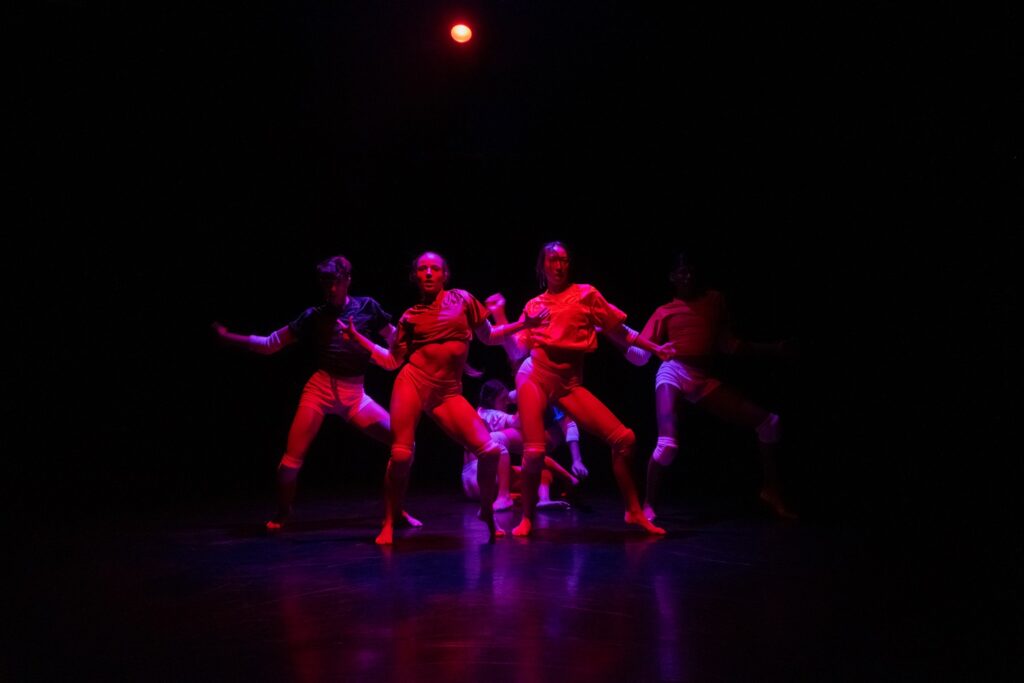
VOICES – Chelsea Roquero, Devin Waxman, Brooke Lutz, Tetiana Sklyarova, Monica Williams, Christopher Hahn in “macho”, choreography by Camila Arana – Photo by Victoria Roman.
macho choreographed by Camila Arana (She/Her) to music by Finnish composer Jaakko Eino Kalevi was in reality a twist on the word machi as it was performed by primarily women, two of which open the piece wrestling. They were dressed in athletic tops cut to reveal their mid sections, white briefs and knee pads. The lighting set them in a wrestling rink with the other performers (and some of the audience) cheering them on. What confused the issue was when the entire group began performing in unison utilizing jazz, hip hop and other dance forms.
Arana’s macho was completely carried on the shoulders of her cast Chelsea Roquero, Devin Waxman, Brooke Lutz, Tetiana Sklyarova, Katherine Mingle, and Christopher Hahn, all of whom were very solid dancers. I enjoyed watching the dancers and Arana’s instincts as a choreographer are good. She needs, however, to settle on a clear theme and stick to it throughout the entire work.
Skink was choreographed and performed by Augustine Perez (He/Him) to music by Venezuelan born musician Arca. My research on the word skink revealed that it means a small lizard or a slang word that appears to mean just about anything from neato to draw, pour out, or serve a drink. The movement was club dance-ish, in-your-face movement with a large element of punk attached to it – including Perez’s tongue dyed or tattooed (unclear) bright green. I enjoyed the performance but the work came across as a work-in-progress and needs to go back to the studio for repairs. Confrontational choreography can be wonderfully disturbing. skink was not.
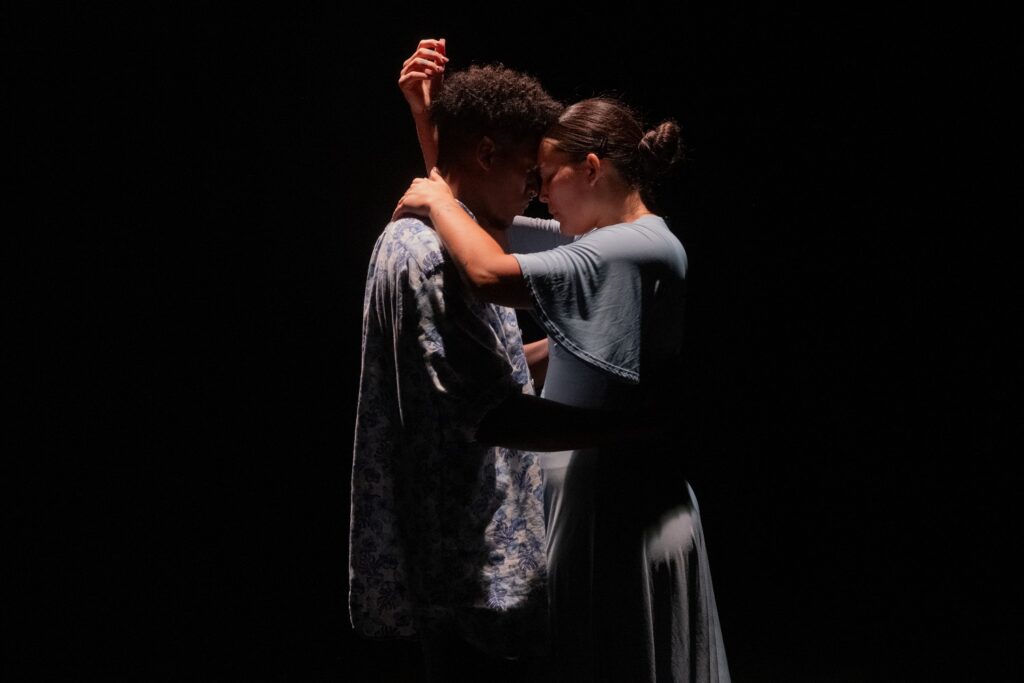
VOICES – Maria I Garcia , Jose Jose Arrieta in “Interconectados”, choreography by Maria Garcia – Photo by Victoria Roman.
Choreographed by Maria Garcia (She/Her) to music by Rodrigo Amarante and Jim Nash, Interconectados was a love duet that came so close to breaking the mold of an overworked subject. Beautifully and honestly performed by Maria I Garcia and Jose Jose Arrieta, Garcia held steadfast to a new look into a romantic relationship with a combination of social dances such as the cha cha and samba while integrating facial and hand gestures to enhance their story. I was thinking, ‘finally a love duet without an obvious quarrel and apology section’, when Garcia did just that.
We knew that the couple’s relationship was complex via their expressions and the way they were dancing together. Selfishly, I wanted Garcia to follow through with what she began. It was, however, a very well done work and the dancers were enchanting.
The final work on the program was JUNGLE, a was high energy and a great close to the evening choreographed by Erika Soto (She/They) to music by British electronic group JUNGLE. Although the connection between the title, the opening scene with the woman crying and the free for all street dance style movements was far from clear, the work was entertaining and well performed.
The full cast of macho was Anasha Milton, Casey Shea, Catherine Liepins, David Bernal-Fuentes, Grace Parker, Jessica Alba, Kaitlyn Carson, Kaley Logan, Krystal Castillo, Lily Chumas, Madi Thomas, Nia Mason, Olivia Vannucci, and Rachel Moreno
Director, producer and stage manager for Voices was Derrick Paris and the wide-ranging and elegant lighting design was by Kate Hutter-Mason.
To learn more about Derrick Paris, please visit his website.
To learn more about Stomping Ground L.A., please visit their website.
This article was edited at 11:08 am on 10/21/23.
Written by Jeff Slayton for LA Dance Chronicle.
Featured image: VOICES – Santiago Villarreal in his work Aquí – Photo by Victoria Roman.

